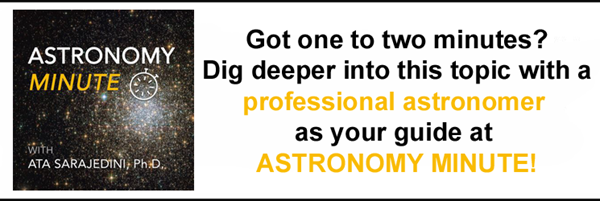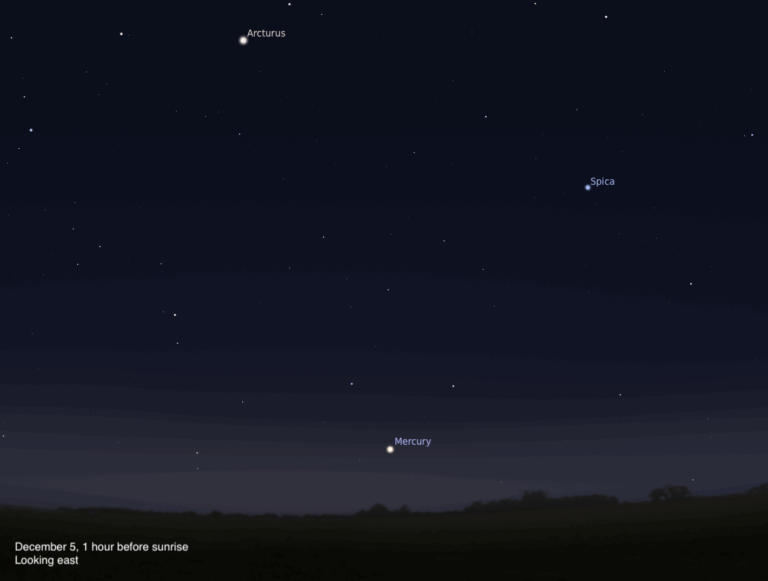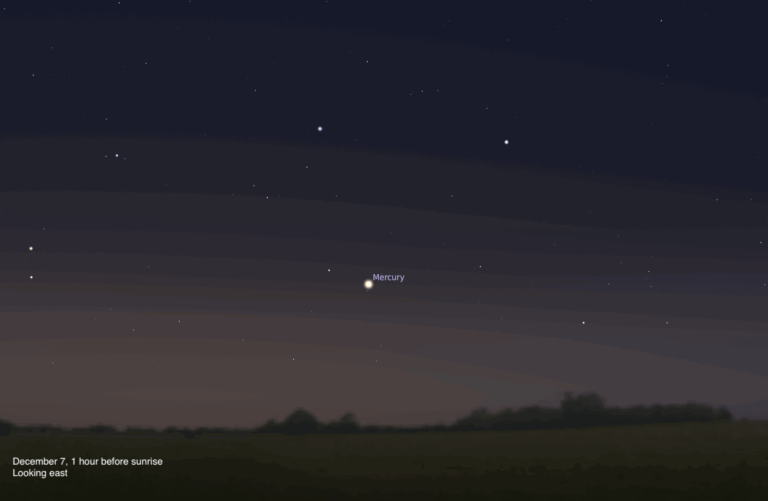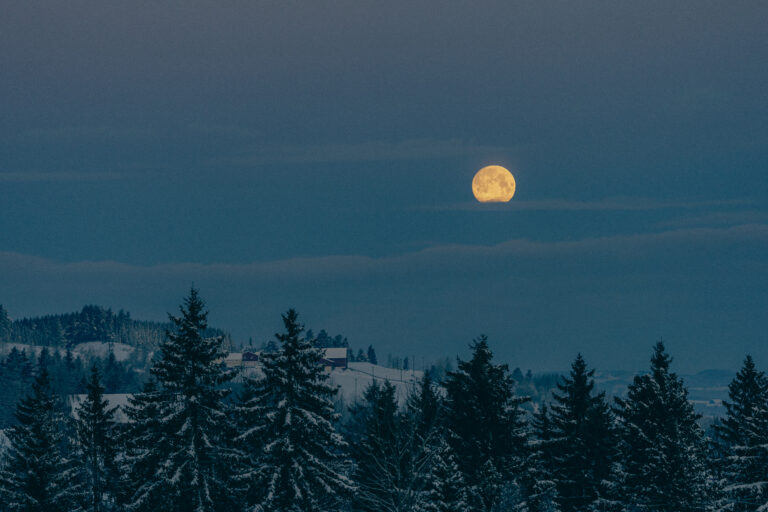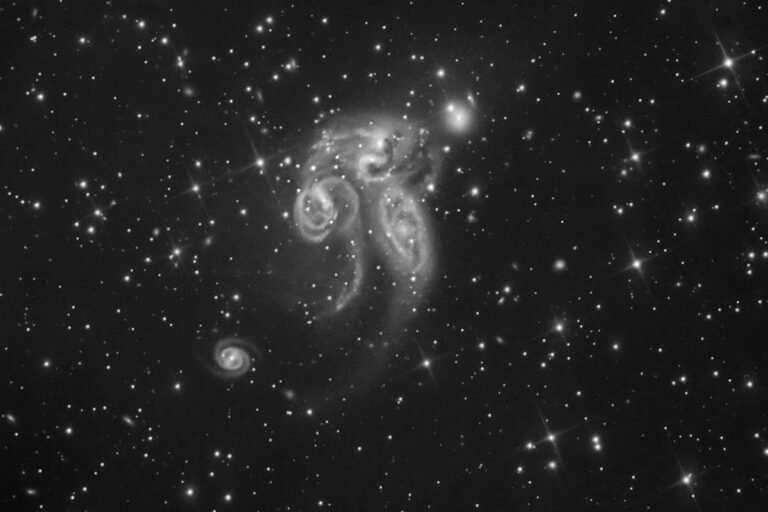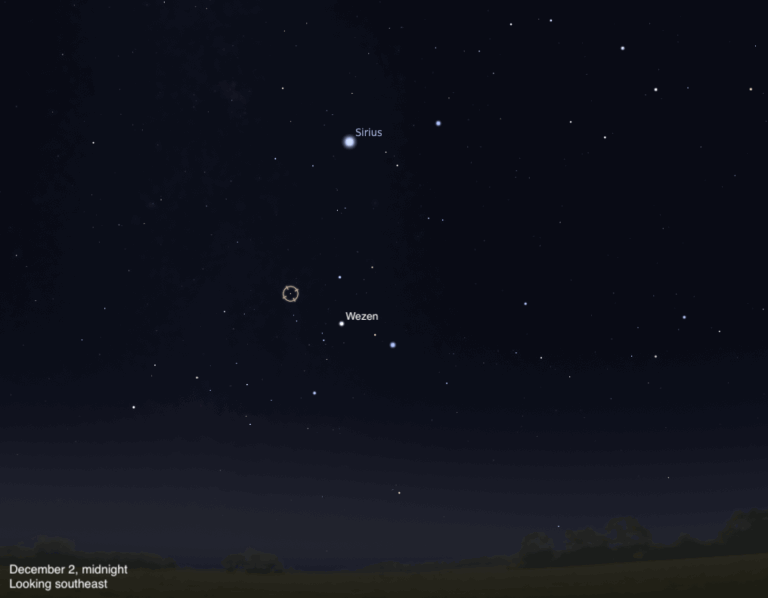Key Takeaways:
Friday, March 18
The March Full Moon, also called the Worm Moon, reaches 100 percent lit at 3:18 A.M. EDT. When Full, our satellite sets around sunrise and rises around sunset, casting its bright light across the sky all night.
During Full Moon, the Sun appears directly overhead in the lunar sky as the entire side of the Moon that faces Earth is illuminated. This can wash out much of the texture on our satellite’s surface, as shadows are shortest and the light reflected back at us is brightest. Even so, the Moon is perhaps the easiest object in the night sky to observe; binoculars or a telescope can still bring out exquisite detail, even at this time. To avoid unpleasantly watering eyes and complete loss of your night vision, opt for a Moon filter or simply bump up the magnification to reduce the portion of the surface you’re observing. This will result in less light streaming through your eyepiece — and into your eye. Alternatively, you can also use a tripod-mounted pair of binoculars or telescope to project the Full Moon’s image onto a nearby flat surface.
Sunrise: 7:07 A.M.
Sunset: 7:10 P.M.
Moonrise: 7:47 P.M.
Moonset: 7:36 A.M.
Moon Phase: Full
*Times for sunrise, sunset, moonrise, and moonset are given in local time from 40° N 90° W. The Moon’s illumination is given at 12 P.M. local time from the same location.
Saturday, March 19
Most casual observers have heard of the Summer Triangle, but have you heard of the Spring Triangle? This trio of stars is visible during Northern Hemisphere springtime nights — and we’re about to welcome spring tomorrow, so today is the perfect time to enjoy this target.
The Spring Triangle contains the bright stars Arcturus (Alpha [α] Boötis, magnitude 0), Spica (Alpha Virginis, magnitude 1), and Denebola (Beta [β] Leonis, magnitude 2). By about two hours after sunset, all three stars have cleared the horizon. Note that the waning gibbous Moon, now 96 percent lit, sits about 4.5° north of Spica, somewhat diminishing the luminary’s light. Spica itself is a variable star, ranging from magnitude 0.92 to 1.04 every 4 days. The source of this variation? Spica is not a single star, but a binary system comprising two suns just 0.12 astronomical unit apart (1 astronomical unit, or AU, is the average Earth-Sun distance, and Mercury orbits 0.387 AU from the Sun). Their orbits, which take them around each other every 4.0145 days, are so close that the stars tug on each other, distorting their shapes so they are not quite spherical and causing the 4-day change in brightness.
Sunrise: 7:05 A.M.
Sunset: 7:11 P.M.
Moonrise: 8:56 P.M.
Moonset: 8:00 A.M.
Moon Phase: Waning gibbous (98%)
Sunday, March 20
Venus reaches greatest western elongation at 5 A.M. EDT, now 47° from the Sun. The planet rises around 5 A.M. local time, roughly two hours before the Sun. Through a telescope, Venus’ magnitude –4.5 disk appears 50 percent lit and stretches 25″ across. To its lower right (south) is Mars. The Red Planet is a much dimmer magnitude 1.2, so you’ll want to seek it out well before sunrise.
If you have a clear eastern horizon and a trusty alarm clock, you might try to spot Mercury and Jupiter shortly before sunrise, when the two are 1.7° apart. Mercury will pass 1.3° directly south of Jupiter at 6 P.M. EDT this evening. This morning, brighter Jupiter (magnitude –2.0) sits northeast of Mercury (magnitude –0.7). But take care — the pair rises a mere 15 minutes or so before the Sun and will barely stand 3° above the horizon when dawn breaks. You’ll want to use that alarm to stop observing several minutes before the Sun will rise to avoid serious permanent damage to your eyes. If you aren’t sure what you’re looking for, just wait a few weeks — Mercury will dip out of sight, but Jupiter is becoming steadily easier to see as time goes by.
The vernal equinox occurs at 11:33 A.M. EDT, welcoming spring to the Northern Hemisphere.
Sunrise: 7:03 A.M.
Sunset: 7:12 P.M.
Moonrise: 10:08 P.M.
Moonset: 8:26 A.M.
Moon Phase: Waning gibbous (93%)
Monday, March 21
Ursa Major is high in the north after dark this evening. Let’s look to the Great Bear, whose rear end forms what is perhaps one of the best-known asterisms: the Big Dipper.
The Dipper’s handle depicts the bear’s unnaturally stretched-out tail. Second from the end is a famous double star formed by 2nd-magnitude Mizar and 4th-magnitude Alcor. The two are separated by just under 12′ — enough for the eagle-eyed to spot without any optical aid at all, particularly when they are high and seeing conditions are good. Try this natural eye test for yourself!
Magnify the view, and you will see a there’s more going on than meets the eye. Mizar itself is a close binary separated by 14″ — easy to split with a telescope. What you can’t see is that each of these stars is also a double, so you’re looking at four stars, not two. Astronomers have also discovered that Alcor is a binary, making this a potentially sextuple-star system.
Although researchers have not solidly confirmed that Mizar and Alcor are themselves bound together, many suspect this is the case.
Sunrise: 7:02 A.M.
Sunset: 7:13 P.M.
Moonrise: 11:22 P.M.
Moonset: 8:55 A.M.
Moon Phase: Waning gibbous (86%)
Tuesday, March 22
Uranus is nearing the end of a close pass by the 7th-magnutude red giant field star HIP 12349 in Aries. This evening, the planet is 0.3° north of the star, with the pair located in the southeastern region of the constellation, roughly halfway between Hamal in Aries and Menkar in Cetus. Star-hoppers can drop down about 1.3° west-southwest of Omicron (ο) Arietis to find them. You may even notice the significant color contrast between Omicron and HIP 12349 — the former is blue-white, while the other is orangey-red. Uranus itself will appear as a small, “flat” star with a grayish cast. Its disk is just 3″ across.
Keep coming back each night, and you’ll see Uranus pull away from the red giant and approach Omicron through the end of the month, ending March roughly 0.8° west of this star.
Sunrise: 7:00 A.M.
Sunset: 7:14 P.M.
Moonrise: —
Moonset: 9:28 A.M.
Moon Phase: Waning gibbous (77%)
Wednesday, March 23
The Moon reaches perigee — the closest point to Earth in its orbit — at 7:37 P.M. EDT. At that time, our satellite will float 229,758 miles (369,760 kilometers) away.
With no Moon lighting the sky this evening, let’s take a look at what many consider the spring season’s best globular cluster: M3. You’ll find this dense ball of stars in far southeastern Canes Venatici, near the border of Boötes. The cluster sits halfway between bright Arcturus in the Herdsman and Cor Caroli in the Hunting Dogs. You can also use 4th-magnitude Beta (β) Comae Berenices as a pointer — M3 sits 6.7° east of this star.
M3 shines at 6th magnitude over a span of about 18′. It’s easy to observe with binoculars or any small scope. This bright, concentrated cluster contains some half a million stars, among them numerous variable stars. Although Messier discovered M3 in 1764, the fuzzy patch of light wasn’t resolved into stars until 20 years later, by William Herschel.
Sunrise: 6:58 A.M.
Sunset: 7:15 P.M.
Moonrise: 12:36 A.M.
Moonset: 10:08 A.M.
Moon Phase: Waning gibbous (67%)
Thursday, March 24
This morning, Venus forms the tip of a triangle with Mars and Saturn in the predawn sky. An hour before sunrise, the trio is about 8° high in the southeast; Saturn and Mars float in Capricornus, while Venus sits just over the border in Aquarius.
Highest in the sky is Venus, shining at magnitude –4.4. To its lower right (southwest) and near the 4th-magnutude star Theta (θ) Capricorni is Mars, magnitude 1.1. To Venus’ lower left (east) is magnitude 0.7 Saturn, standing directly above Gamma (γ) Capricorni. Venus is now a 52-percent-lit crescent, easy to view through binoculars or a telescope. Mars’ small, ruddy disk will show little detail, particularly while it’s so low in the growing twilight. Saturn’s disk spans 16″ and its rings stretch roughly twice that, offering a stunning view through a small telescope. The planet is surrounded by several moons, but these will be hard to pick out due to the low altitude and brightening background.
Sunrise: 6:57 A.M.
Sunset: 7:16 P.M.
Moonrise: 1:49 A.M.
Moonset: 10:58 A.M.
Moon Phase: Waning gibbous (56%)
Friday, March 25
Last Quarter Moon occurs at 1:37 A.M. EDT. Our satellite is currently in Sagittarius, rising around 3 A.M. inside the top of the Teapot asterism formed by several of the constellation’s brighter stars. This is also the direction of the Milky Way’s center, and the region is rich in deep-sky objects. Even at Last Quarter, however, the Moon’s light will interfere and we’ll need to wait until our satellite has passed from this part of the sky to look deeper.
Focus in on the Moon, and you’ll enjoy stunning views of stark shadows along the terminator separating lunar night from day. As darkness slowly falls across the Moon’s face, features are lit from the opposite side as during the waxing phases. Look for features just on the bright side of the stark terminator, such as the long, sweeping curve of the Apennine Mountains in the north or the several smaller craterlets inside the large crater Clavius, located in the lunar south.
Later in the morning as sunrise nears, Venus still sits in roughly the same spot between Mars and Saturn. The bright planet has moved only slightly northeast (left) since yesterday — can you spot the difference?
Sunrise: 6:55 A.M.
Sunset: 7:18 P.M.
Moonrise: 2:56 A.M.
Moonset: 11:57 A.M.
Moon Phase: Waning crescent (45%)






